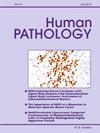Severe eosinophilic gastritis is associated with peripheral eosinophilia and multi-organ involvement
IF 2.6
2区 医学
Q2 PATHOLOGY
引用次数: 0
Abstract
Histologic gastric eosinophilia (HGE), characterized by dense eosinophil infiltration in gastric mucosa, is an understudied disease with unclear etiology. Unlike its counterpart, eosinophilic esophagitis (EoE), which has defined diagnostic eosinophil thresholds and characteristic endoscopic findings, proposed eosinophil thresholds for the diagnosis of HGE vary and endoscopic findings are not well characterized.
This study aimed to assess the clinical, histological, and endoscopic features of HGE in adults and children. A cohort of 50 HGE patients were identified (20 children, 30 adults; 58.0 % male). The majority (70.0 %) had an allergic/atopic history. Pediatric patients with HGE were significantly more likely to have a history of food allergy (P = 0.013) and less likely to have drug allergy (P = 0.001) compared to adults.
The most common endoscopic finding was ulceration/erosion (34.0 %). Multiorgan GI-tract involvement was seen in 40.9 % of patients, primarily affecting the esophagus (39.0 %) and duodenum (15.4 %).
HGE cases were stratified by severity into G1 (50–100 eosinophils/HPF; 11 patients) and G2 (>100 eosinophils/HPF; 39 patients) groups for comparison. Patients with G2 HGE had higher rates of peripheral eosinophilia (P = 0.010) and multiorgan GI involvement (P = 0.047) compared to those with G1 HGE.
In conclusion, HGE often presents as a gastric ulcer and is strongly associated with food allergy in children and drug allergy in adults. Severe HGE is more likely than moderate HGE to present with peripheral eosinophilia and concomitant eosinophilia elsewhere in the GI tract, therefore, noting the presence of severe HGE may be helpful in guiding clinical follow up.
严重嗜酸性胃炎与外周嗜酸性粒细胞增多和多器官受累有关
组织学胃嗜酸性粒细胞增多症(HGE)是一种病因不明的未被充分研究的疾病,其特征是胃粘膜内嗜酸性粒细胞密集浸润。与嗜酸性粒细胞性食管炎(EoE)不同,它有明确的诊断性嗜酸性粒细胞阈值和特征性的内镜检查结果,但HGE诊断的嗜酸性粒细胞阈值各不相同,内镜检查结果也没有很好的特征。本研究旨在评估成人和儿童HGE的临床、组织学和内镜特征。确定了50例HGE患者的队列(20例儿童,30例成人,58.0%男性)。大多数(70.0%)有过敏/特应性史。与成人相比,患有HGE的儿童患者有食物过敏史的可能性更高(P = 0.013),药物过敏的可能性更低(P = 0.001)。最常见的内镜发现是溃疡/糜烂(34.0%)。40.9%的患者累及多器官胃肠道,主要累及食道(39.0%)和十二指肠(15.4%)。将HGE病例按严重程度分为G1组(50-100个嗜酸性粒细胞/HPF组,11例)和G2组(100个嗜酸性粒细胞/HPF组,39例)进行比较。与G1 HGE患者相比,G2 HGE患者外周血嗜酸性粒细胞增多(P = 0.010)和多器官GI受累(P = 0.047)的发生率更高。总之,HGE通常表现为胃溃疡,并与儿童的食物过敏和成人的药物过敏密切相关。与中度HGE相比,重度HGE更有可能出现外周嗜酸性粒细胞增多和伴随的胃肠道其他部位嗜酸性粒细胞增多,因此,注意重度HGE的存在可能有助于指导临床随访。
本文章由计算机程序翻译,如有差异,请以英文原文为准。
求助全文
约1分钟内获得全文
求助全文
来源期刊

Human pathology
医学-病理学
CiteScore
5.30
自引率
6.10%
发文量
206
审稿时长
21 days
期刊介绍:
Human Pathology is designed to bring information of clinicopathologic significance to human disease to the laboratory and clinical physician. It presents information drawn from morphologic and clinical laboratory studies with direct relevance to the understanding of human diseases. Papers published concern morphologic and clinicopathologic observations, reviews of diseases, analyses of problems in pathology, significant collections of case material and advances in concepts or techniques of value in the analysis and diagnosis of disease. Theoretical and experimental pathology and molecular biology pertinent to human disease are included. This critical journal is well illustrated with exceptional reproductions of photomicrographs and microscopic anatomy.
 求助内容:
求助内容: 应助结果提醒方式:
应助结果提醒方式:


